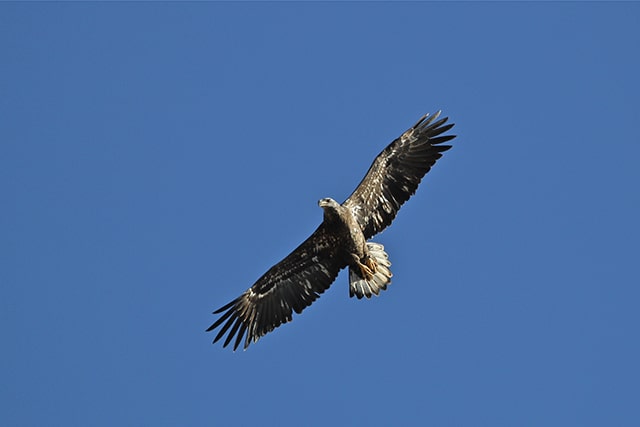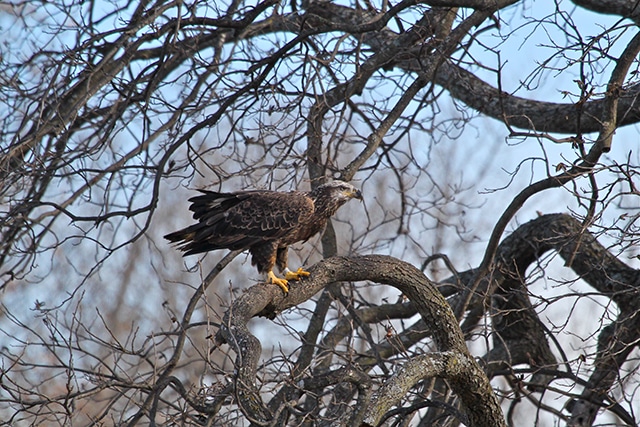 The first calendar day of spring is right around the corner but we can already see the grass beginning to turn green underneath winter’s brown coat. The great-horned owls that have taken up in the hollow of the old pecan tree behind the aviary have already hatched at least one owlet this season. We found the pipped egg shell that had been tossed from the hollow the night before lying at the base of the tree. We have also seen the herons carry nest material across to their roost east of the aviary and the red-tailed hawks are putting on aerial displays of courtship. Their nesting season is approaching as well.
The first calendar day of spring is right around the corner but we can already see the grass beginning to turn green underneath winter’s brown coat. The great-horned owls that have taken up in the hollow of the old pecan tree behind the aviary have already hatched at least one owlet this season. We found the pipped egg shell that had been tossed from the hollow the night before lying at the base of the tree. We have also seen the herons carry nest material across to their roost east of the aviary and the red-tailed hawks are putting on aerial displays of courtship. Their nesting season is approaching as well.
As the seasons change, we anticipate Wadasé Zhabwé will most likely return to the area of the Salt Fork River near Ponca City, Okla. She spent the majority of the summer in that area after May when she ventured north to Keystone Lake as the white bass were spawning. We will be watching to see if patterns in her travels match her previous year.
Wadasé continues to visit the aviary frequently, although she spends less time on the grounds since we have had mild weather the past month. She may fly in early in the morning and be gone before the sun is above the tree tops. On sunny days we see her in the distance flying high above the river. Occasionally, she returns late in the evening before going to roost down towards the river.
Sitting down to write this update there hadn’t been much new information to include until the previous week’s telemetry became available. On February 6 she did something we didn’t expect.
She had spent the past week to the northeast of the aviary in the community of Johnson and worked her way around the river back west to Mcloud before going on to Harrah near the eagle nest on Horseshoe Lake. However, she only stayed overnight near Harrah on this trip. On the sixth, telemetry shows her path back down the North Canadian River towards the aviary but instead of crossing HWY 177 and coming home, she followed the highway south for a bit and then veered further southeast when she reached Highway 9.
She flew right between Tribbey and Etowah and continued straight on until she reached the South Canadian River, stopping just north of Rosedale for the night. The next day she followed the river back towards Purcell before crossing over I-35 and heading towards Lindsay. She stopped along the Washita River east of Lindsay for the evening.
 On the eighth she headed further east along the Washita stopping near Maysville in a sharp bend in the river to hunt for several hours before she headed back west past Lindsay stopping again for the night on the Washita near Bradley. Telemetry isn’t in for her trip home but we know that she flew over 50 miles late afternoon on the ninth because she came flying in above the aviary. She made a wide circle around the property and came in closer for one pass as if to say hello and headed off to the pasture west of the aviary. We spotted her again just before sunset following adult eagle towards the river. This trek to southern Oklahoma was her furthest trip south and west to date.
On the eighth she headed further east along the Washita stopping near Maysville in a sharp bend in the river to hunt for several hours before she headed back west past Lindsay stopping again for the night on the Washita near Bradley. Telemetry isn’t in for her trip home but we know that she flew over 50 miles late afternoon on the ninth because she came flying in above the aviary. She made a wide circle around the property and came in closer for one pass as if to say hello and headed off to the pasture west of the aviary. We spotted her again just before sunset following adult eagle towards the river. This trek to southern Oklahoma was her furthest trip south and west to date.
If she makes more trips south we will have to go and see if she has found another nest to visit. One thing is certain, eagles pick nest sites based on availability of food to raise their family, so Wadasé is gaining valuable knowledge as she visits these places as well as finding great hunting spots.
Her telemetry data continues to be a valuable tool in understanding and learning about the behavior of juvenile bald eagles. To follow her movements with us you can visit www.arcgis.com/home and search for “Potawatomi eagle.”
Send your encounters with Wadasé or any other eagles in the state or wherever you may be to Jennifer.randell@potawatomi.org. All your reports have been a great help in monitoring her movements away from the aviary grounds.
For more information or to read previous updates please visit https://www.potawatomi.org and search Wadasé or you can visit https://www.potawatomi.org/about-wadase.
